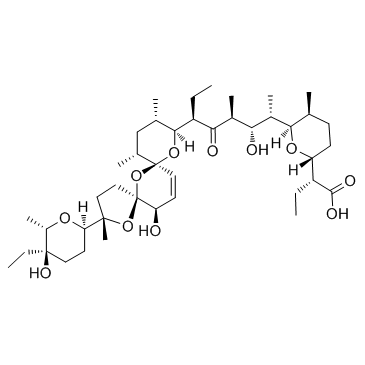Salinomycin

Salinomycin structure
|
Common Name | Salinomycin | ||
|---|---|---|---|---|
| CAS Number | 53003-10-4 | Molecular Weight | 751.00 | |
| Density | 1.2±0.1 g/cm3 | Boiling Point | 839.2±65.0 °C at 760 mmHg | |
| Molecular Formula | C42H70O11 | Melting Point | 112.5-113.5 °C(lit.) | |
| MSDS | Chinese USA | Flash Point | 243.2±27.8 °C | |
| Symbol |

GHS06 |
Signal Word | Danger | |
|
Triggering of erythrocyte cell membrane scrambling by salinomycin.
Basic Clin Pharmacol Toxicol. 115(5) , 396-402, (2015) Salinomycin, a polyether ionophore antibiotic effective against a variety of pathogens, has been shown to trigger apoptosis of cancer cells and cancer stem cells. The substance is thus considered for the treatment of malignancy. Salinomycin compromises tumour... |
|
|
High sensitive multiresidue analysis of pharmaceuticals and antifungals in surface water using U-HPLC-Q-Exactive Orbitrap HRMS. Application to the Danube river basin on the Romanian territory.
Sci. Total Environ. 532 , 501-11, (2015) The occurrence of 67 pharmaceutical and antifungal residues in the Danube river on the Romanian territory was studied by using solid-phase extraction (SPE) and LC-Q Exactive Orbitrap high resolution MS in both full scan (FS) MS and targeted MS/MS modes. A sin... |
|
|
ROS-p53-cyclophilin-D signaling mediates salinomycin-induced glioma cell necrosis.
J. Exp. Clin. Cancer Res 34 , 57, (2015) The primary glioblastoma multiforme (GBM) is the most malignant form of astrocytic tumor with an average survival of approximately 12-14 months. The search for novel and more efficient chemo-agents against this disease is urgent. Salinomycin induces broad ant... |
|
|
Irinotecan treatment and senescence failure promote the emergence of more transformed and invasive cells that depend on anti-apoptotic Mcl-1.
Oncotarget 6(1) , 409-26, (2015) Induction of senescence by chemotherapy was initially characterized as a suppressive response that prevents tumor cell proliferation. However, in response to treatment, it is not really known how cells can survive senescence and how irreversible this pathway ... |
|
|
Laser-induced fluorescence reader with a turbidimetric system for sandwich-type immunoassay using nanoparticles.
Anal. Chim. Acta 883 , 32-6, (2015) A unique laser-induced fluorescence (LIF) reader equipped with a turbidimetric system was developed for a sandwich-type immunoassay using nanoparticles. The system was specifically designed to reduce experimental error caused by particle loss, aggregation and... |
|
|
Effects of salinomycin and CGP37157 on head and neck squamous cell carcinoma cell lines in vitro.
Mol. Med. Report. 12 , 4455-61, (2015) Surgery, radiation, chemotherapy or a combinations of these are all accepted modalities for the treatment of head and neck squamous cell carcinoma (HNSCC). Despite this, 40‑60% of patients suffering from HNSCC develop loco‑regional failure and/or distant meta... |
|
|
Rapid method for the simultaneous determination of six ionophores in feed by liquid chromatography/mass spectrometry.
J. AOAC Int. 95(4) , 1016-22, (2012) A simple and highly sensitive LC/MS method was developed for the simultaneous determination of six ionophores--lasalocid, monensin, laidlomycin, maduramycin, salinomycin, and narasin--in feed. The procedure involved extraction of 1 g of feed with 4 mL of meth... |
|
|
Passive sampling: A cost-effective method for understanding antibiotic fate, behaviour and impact.
Environ. Int. 85 , 284-91, (2015) The occurrence of antibiotics in the environment has raised much concern in recent years. Understanding their release, fate and behaviour in the environment is vital to assess potential risks. In this study, a novel passive water sampler - diffusion gradients... |
|
|
Three-Dimensional Cell Culture-Based Screening Identifies the Anthelmintic Drug Nitazoxanide as a Candidate for Treatment of Colorectal Cancer.
Mol. Cancer Ther. 14 , 1504-16, (2015) Because dormant cancer cells in hypoxic and nutrient-deprived regions of solid tumors provide a major obstacle to treatment, compounds targeting those cells might have clinical benefits. Here, we describe a high-throughput drug screening approach, using gluco... |
|
|
The Hedgehog signalling pathway mediates drug response of MCF-7 mammosphere cells in breast cancer patients.
Clin. Sci. (Lond.) 129 , 809-22, (2015) BCSCs (breast cancer stem cells) have been shown to be resistant to chemotherapy. However, the mechanisms underlying BCSC-mediated chemoresistance remain poorly understood. The Hh (Hedgehog) pathway is important in the stemness maintenance of CSCs. Nonetheles... |